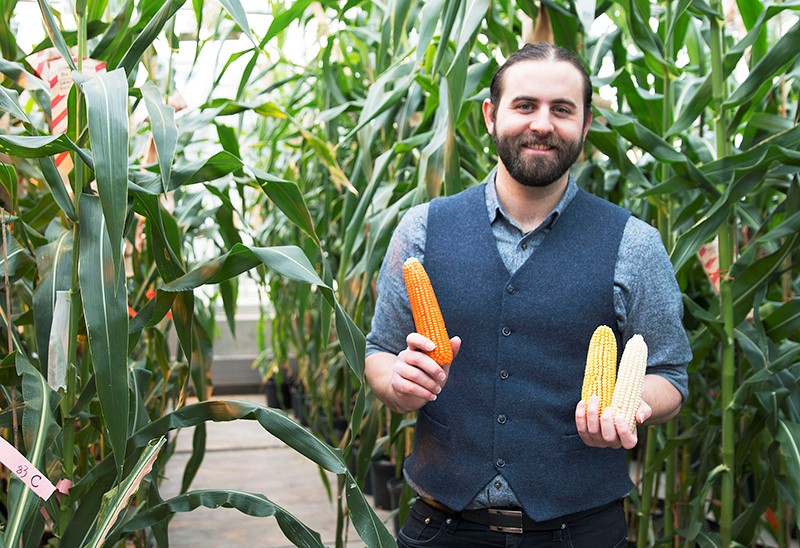Biofortification process naturally increases provitamin A carotenoid content in corn so it's more nutritious with deeper orange color.
February 12, 2019

“Orange corn,” a more nutritious, naturally bred variety of corn, is now available in U.S. markets through Purdue-affiliated start-up NutraMaize LLC.
Torbert Rocheford, the Patterson endowed chair in translational genomics for crop improvement in the Purdue University College of Agriculture's department of agronomy, used a process known as biofortification to naturally increase the amount of provitamin A carotenoids in corn, making the corn more nutritious and creating a rich orange color. The human body converts certain provitamin A carotenoids, such as beta-carotene, into vitamin A, an essential vitamin that promotes eye health and supports the immune system.
“The project began as part of an ongoing humanitarian effort called HarvestPlus to improve nutrition in developing countries,” said Rocheford, who began working on naturally increasing the amount of health-benefiting carotenoids in corn more than 20 years ago. “As the orange corn grew in popularity and demand overseas, I decided to grow some here and share it. The response was overwhelmingly positive. I had people tell me that the orange corn made the best grits and cornbread they had ever eaten. The logical next step was to make the unique corn available across the U.S.”
Rocheford and his son Evan co-founded NutraMaize to commercialize the corn in the U.S. NutraMaize is marketing the corn under the brand name “Professor Torbert's Orange Corn,” and it is available at ProfessorTorberts.com. A video about the corn can be viewed here.
“The name of the product is a homage to my father's lifelong dedication to improving the world through science and agriculture,” NutraMaize chief executive officer Evan Rocheford said.
The bright-orange corn, derived from varieties that originated in South America and the Caribbean, is not the variety eaten off the cob. It is milled to make products such as cornmeal, grits and polenta.
“People have described the corn products as having rich, kind of nutty, buttery flavors,” Evan Rocheford said.
Torbert Rocheford developed the orange corn using traditional breeding techniques rather than genetic modification. The orange color of the corn comes from natural plant pigments called carotenoids, the same family of compounds that give carrots their orange color. Carotenoids naturally occur in corn, but the low concentrations are typically only enough to produce a pale-yellow color.
“Although it sounds like a relatively simple idea, it's actually quite revolutionary when it comes to a staple crop like corn,” Evan Rocheford said. “We are actively breeding and developing varieties that speak to the two qualities consumers care about most: taste and nutrition.”
Because corn is used in a wide variety of popular food formats in the U.S., including tortillas, chips and cereals, improving the carotenoid content of corn provides an opportunity to significantly increase the amount of the beneficial antioxidants Americans consume without changing their eating habits, Torbert Rocheford said.
Long term, NutraMaize plans to sell its corn as an ingredient to food processors that produce widely consumed products like breakfast cereals and snack foods.
The start-up company has received a Small Business Technology Transfer Research grant, a Small Business Innovation Research grant and other grants totaling about $425,000, the Purdue University news release noted.
Before NutraMaize licensed the technology, Torbert Rocheford's lab also received a $25,000 grant from the Purdue Research Foundation-managed Trask Innovation Fund, an endowed development fund to assist faculty and staff whose discoveries are commercialized through the Purdue Office of Technology Commercialization, through which the orange corn breeding process is licensed.
The start-up also received assistance in developing a business plan and seeking grants from the Purdue Foundry, an entrepreneurship and commercialization accelerator in Discovery Park's Burton D. Morgan Center for Entrepreneurship, as well as assistance from the state of Indiana SBIR/STTR Program.
“When it comes to supporting innovation and economic development, Purdue University and the state of Indiana really put their money where their mouth is,” Evan Rocheford said. “Having a support network like this really makes a huge difference when you're trying to build a company from scratch. We are proud to call ourselves a Purdue Foundry startup and call Indiana home.”
HarvestPlus is developing and promoting new, more nutritious varieties of staple food crops with higher amounts of vitamin A, iron or zinc — three of the micronutrients identified by the World Health Organization as most lacking in diets globally. The process is known as biofortification, and regular consumption of these innovative crops is improving nutrition and public health, the university said.
Source: Purdue University, which is solely responsible for the information provided and is wholly owned by the source. Informa Business Media and all its subsidiaries are not responsible for any of the content contained in this information asset.
You May Also Like

.png?width=300&auto=webp&quality=80&disable=upscale)

